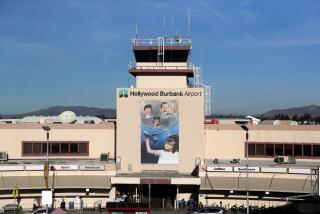Renovation to Restore Hangar to ‘30s Grandeur
- Share via
Hangar No. 1, Los Angeles International Airport’s last link to the days of dirigibles and pioneer aviators such as Charles A. Lindbergh, is getting a $2-million make-over.
The hangar, which was built in 1929 when the airport was known as Mines Field and consisted solely of a dirt landing strip in the middle of bean and barley fields, will undergo the renovations beginning in June. Vacant for about 15 years, the building will be brought up to the city’s earthquake codes and returned to the way it looked decades ago when Lucky Lindy is believed to have used it and when the German dirigible Graf Zeppelin was tied down near its doors.
Officials of the Department of Airports say the work will be done by Texas-based AVIA Development Group Co. The company, acting on behalf of DHL Airways Inc., has agreed to renovate the old hangar in exchange for the right to develop two new cargo buildings nearby.
“What’s driving the project obviously is the two new cargo buildings, since we made this a condition of development,” said Donald Miller, the department’s deputy executive director.
Situated southeast of the airport’s passenger terminals near Imperial Highway, the hangar is the only structure remaining from Mines Field. The two-story brick and concrete building, which was built by the city and then leased to the Curtiss Wright Flying Service, was one of five designed in the Spanish Colonial Revival style. Tens of thousands of spectators lined up near Hangar No. 1 when the airfield hosted the National Air Races in the ‘30s.
Even though it was declared a cultural monument by the city’s Historical Heritage Board in 1966, the hangar, which was built for $35,000, had been earmarked for demolition as recently as the early ‘80s to make way for airport expansion. However, a group of architecture and aviation buffs came to its rescue, persuading airport officials to save it.
Preservationists say the hangar is considered a historical gem because of its architecture, which is noted for its elaborate towers, tile roofs and arches. Christy McAvoy, a Los Angeles preservation consultant who is working with AVIA, said the hangar and its sister buildings were probably built to promote the fledgling airport.
“Los Angeles was trying to create an image for its municipal airport, and this was part of that early image building,” McAvoy said.
Brian Cochran, vice president for AVIA, said the renovation work will be based on the hangar’s original architectural drawings, which were found in the airport’s archives. Once the renovations are completed, an airline will use the building for office and cargo space, he said.
Cochran said the company is now going through the steps necessary to qualify the hangar for inclusion on the government’s National Register of Historic Places. If that occurs, AVIA stands to gain $400,000 in tax credits.
“It is tax credits that make the whole thing pencil in . . . ,” Cochran said. “It is a little creative financing that is enabling the airport to save the structure and us to renovate it back to its original grandeur.”
Cochran said construction on the two new cargo buildings is expected to begin next week. The Department of Airports will retain the title to Hangar No. 1 as well as to the new buildings.
More to Read
Sign up for The Wild
We’ll help you find the best places to hike, bike and run, as well as the perfect silent spots for meditation and yoga.
You may occasionally receive promotional content from the Los Angeles Times.






